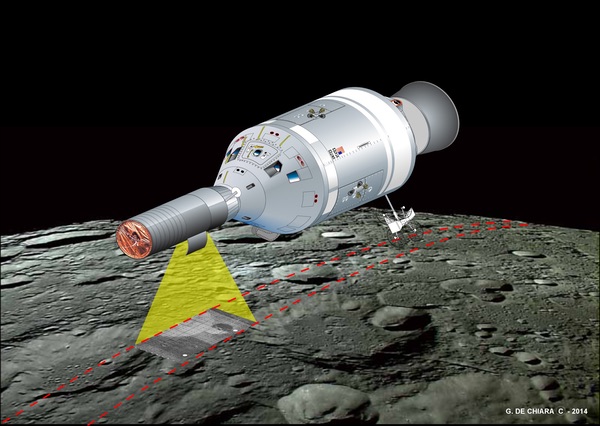Apollo RevisitedThe Eagle has crashed: the top secret UPWARD program and Apollo disastersby Dwayne A. Day
|
| In 2010 the government revealed that NASA and the NRO had a second agreement to cooperate on a backup plan to Lunar Orbiter to provide the data necessary for conducting lunar landings, and actually started construction of hardware. |
Declassified documents indicate that NASA and a secretive organization known as the National Reconnaissance Office (NRO) collaborated on the classified UPWARD program. The goal of UPWARD was in fact to look down from lunar orbit and photograph the Moon in very high resolution in preparation for the lunar landings. But the project made some in the U.S. intelligence community nervous, and once the immediate requirement for it disappeared, the two agencies argued about its continuation.
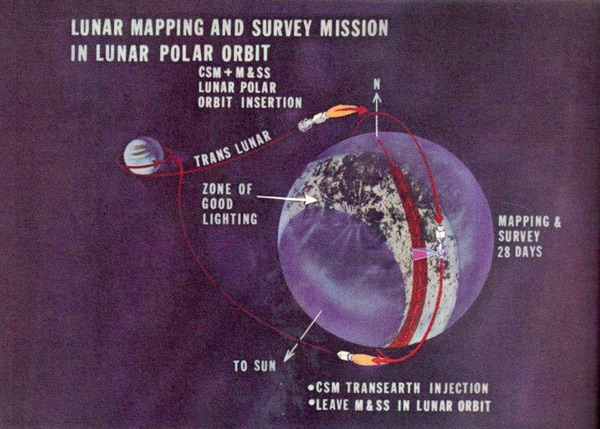 Artist concept from a 1968 encyclopedia showing the LMSS photographing the Moon. The existence of the LMSS was unclassified, although details were secret. Despite this, the LMSS program was overlooked by most histories of the Apollo program. |
Insurance policy
During the early planning phases of the Apollo lunar landing program, NASA engineers were concerned that they knew relatively little about the lunar surface. Although most scientists dismissed suggestions that the Moon might be covered in fine powder that could swallow a Lunar Module, they were primarily guessing about the qualities of the surface. Considering that the astronauts would be flying an untested and finicky vehicle, they needed as much data on the lunar terrain as possible. So, NASA undertook a series of precursor robotic missions that would characterize the lunar surface, providing vital data on the size of surface features, the smoothness of terrain, and especially the slope of the terrain. NASA stripped much of the science from the Surveyor program and directed it toward measuring surface characteristics in support of Apollo, and started the Lunar Orbiter program to photograph potential landing sites.
Lunar Orbiter, which began in 1962, benefitted from access to classified spy satellite technology as a result of an agreement between NASA and the NRO. But in 2010 the government revealed that NASA and the NRO had a second agreement to cooperate on a backup plan to Lunar Orbiter to provide the data necessary for conducting lunar landings, and actually started construction of hardware. Unlike Lunar Orbiter, this hardware would be operated by Apollo astronauts in lunar orbit.
The backup project was known as the Lunar Mapping and Survey System, or LM&SS (often without the ampersand, and sometimes also known as the Apollo Mapping and Survey System.) NASA and the National Reconnaissance Office signed an agreement on LMSS in April 1964, when Lunar Orbiter was still in its infancy. In May 1964 NASA transferred $800,000 to the Department of Defense to cover contractor studies regarding which existing NRO camera systems might be useful for Apollo. The people studying the problem quickly decided upon the GAMBIT-1 reconnaissance camera, which had first entered service in summer 1963 achieving high-resolution from low Earth orbit. GAMBIT-1 also had the designation KH-7. At the Moon, the camera could be used at 30 nautical miles (56 kilometers) altitude to provide high-resolution images of the ground, or from 200 nautical miles (370 kilometers) altitude to provide broader area coverage. The new program was given the classified code name UPWARD, which never appeared in NASA documents.
The initial plan called for mounting the large GAMBIT-1 optics system in Scientific Instrument Module (SIM) bay number 1 of the Apollo Service Module. Contractors would build four test units and two flight units for $36 million. But after conducting a detailed study, the NRO decided to abandon plans to try to modify the camera system for the SIM bay and instead chose to use the camera inside GAMBIT’s Orbiting Control Vehicle (OCV), a cylinder 18 feet (5.5 meters) long and five feet (1.5 meters) in diameter.
| Intelligence community officials were uncomfortable with any public acknowledgement even of the existence of satellite reconnaissance, and would have been completely opposed to revealing any information on satellite cameras that was not vital to the success of Apollo. |
The GAMBIT-1 was, at the time, the most powerful camera system ever carried into space. It had a 44-inch (112-centimeter) primary mirror and a 77-inch (196-centimeter) focal length. The new plan was to carry the OCV with its powerful camera system along with the Apollo command and service modules atop a Saturn V rocket, with the OCV in the compartment reserved for the Lunar Module. The Apollo CSM would detach from the stack, turn around 180 degrees, dock with the OCV, and pull it free. Instead of a Satellite Recovery Vehicle at the front of the spacecraft, there would be a docking adapter, and inside the unpressurized spacecraft forebody would be the film takeup reel. After the reconnaissance mission was over, Apollo astronauts could then depressurize the capsule, open the hatch, reach into the OCV, and detach the film takeup reel—sealed to prevent accidental exposure—and pull it back into the Command Module, all without ever leaving their spacecraft. After they resealed the hatch and repressurized the Command Module, they could detach the OCV and head home.
The GAMBIT-1 camera was manufactured by Kodak. Lockheed built the Satellite Recovery Vehicle, which was not needed for the UPWARD mission. It also built the workhorse Agena upper stage that placed the GAMBIT-1 in orbit and also was not needed. The OCV provided guidance and stabilization for the GAMBIT-1 and was manufactured by General Electric. But the LMSS would stay attached to the Apollo spacecraft and did not require the OCV’s services.
In June 1965, Lockheed won the contract to adapt the camera system for Apollo use. Lockheed was responsible for the film takeup system inside the Satellite Recovery Vehicle, and this would have required modification so that it could be handled by an astronaut. By the fall of 1965, the system design was finalized. Lockheed would also provide the shell that encased the camera system, based upon the shell that the company was producing for the upgraded GAMBIT-3 reconnaissance satellite. Thus, the GAMBIT-1 optical system would be mounted within a GAMBIT-3 shell.
Lockheed’s contract required that it deliver the first UPWARD unit in July 1967, with a flight test in low Earth orbit in December. Although it was not until 1967 that the Apollo program developed the Apollo A thru J designations for the different steps in the program, an Earth orbit test would have essentially been the equivalent of an Apollo D class mission. It is difficult to speculate which Apollo mission number or crew would have flown this mission in late 1967. At least one of the missions would be conducted in Earth orbit to test the equipment. But after that mission, the next one would involve launching a Saturn V to the Moon.
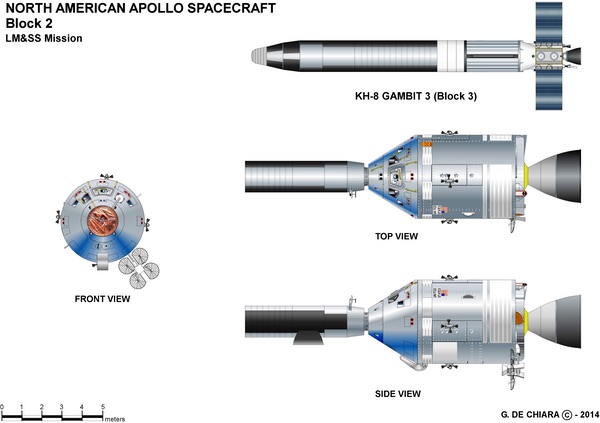 The Lunar Mapping and Survey System, under the classified code name UPWARD, was derived from the GAMBIT-1 camera system and the GAMBIT-3 control vehicle. It would have been carried around the Moon by an Apollo spacecraft. (credit: G. De Chiara) |
Lunar Orbiter takes flight
As work was progressing on these top-secret spacecraft for Apollo, NASA began launching the Lunar Orbiter missions. Lunar Orbiter I launched in August 1966, followed by Lunar Orbiter II in November 1966. Both missions were successful, and a NASA official concluded that these missions had “certified” several Apollo landing sites. But not everybody in NASA agreed, with several persons arguing that the Lunar Orbiter photographs had not provided sufficient data on the slope of the terrain at the potential landing sites.
In January 1967, the Apollo 1 fire dealt a major setback to the program and the schedule. As NASA investigated the fire and determined how to recover from it, this provided a pause that allowed those who were overseeing the LMSS to consider its future. It also exposed a rift between those at NASA who saw LMSS as a powerful tool that the civilian space agency could use, either at the Moon or in Earth orbit, and those in the secretive reconnaissance community, who wanted to preserve the secrecy that surrounded their activities, which they considered vital to national security.
By April 1967, NASA Associate Administrator Robert Seamans, who had been the primary point of contact with the National Reconnaissance Office, discussed the future of the Lunar Mapping and Survey System program with DoD and NRO officials. Seamans had also ordered a comprehensive review of basing the landing decision on the imagery returned by Lunar Orbiter. DoD and intelligence community officials discussed three options: cancellation, continuation without testing in Earth orbit, and continuation with testing in Earth orbit. The Earth orbit testing option would have been particularly problematic because it would have resulted in the production of possibly unclassified high-resolution images of the Earth and attracted a great deal of attention to the classified reconnaissance program.
| It might be useful to have a low-cost way of photographing equipment on the lunar surface in event of an accident, especially for the first landing mission. |
Seamans also proposed an additional option of converting the LMSS to scientific exploration of the Moon, presumably for an Apollo mission after the initial lunar landing. For the intelligence community, the problem with Seamans’ proposal was that it still would have required publicly revealing the existence of the LMSS and its powerful optics system, raising potentially embarrassing questions about the nation’s top-secret reconnaissance program. In addition to the LMSS hardware, NRO and NASA officials had drafted a cover story and procedures for revealing the existence of the camera system. Intelligence community officials were uncomfortable with any public acknowledgement even of the existence of satellite reconnaissance, and would have been completely opposed to revealing any information on satellite cameras that was not vital to the success of Apollo.
In the meantime, Lunar Orbiter III had flown in February 1967, and Lunar Orbiter IV had flown in May. Both returned useful pictures, further undercutting the requirement for the secret UPWARD program.
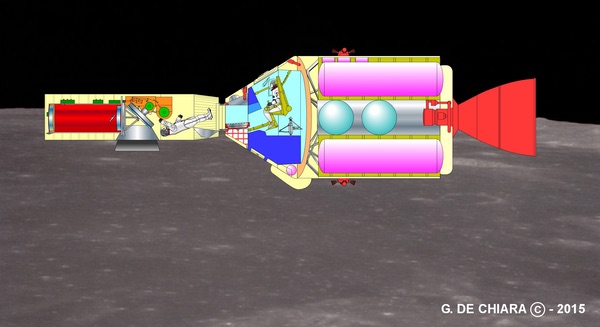 Cutaway showing the internal arrangement of the Lunar Mapping and Survey System that would have been carried around the Moon. (credit: G. De Chiara) |
Vanishing requirement
The original justification for LMSS was, in the words of one NASA official “a backup Apollo site certification capability in the event of Surveyor or Lunar Orbiter inadequacies.” But by spring 1967 it was no longer required for this role. Some at NASA believed that it could accomplish other missions.
By June 1967, four locations had been certified as acceptable landing sites for the Lunar Module, and the last Lunar Orbiter, if successful, would certify four more landing sites. There was discussion within NASA about ending the LMSS, and by late June there were internal memos about the future requirement for the camera system. Apollo officials were reluctant to give up the system and proposed several reasons for keeping it. One reason was that until astronauts had actually landed on the Moon, they would not know how good the Lunar Orbiter data was compared to the actual landing site. The more powerful LMSS might still be required. In addition, the early landing sites were all in relatively easy—flat and smooth—locations. However, NASA was considering more challenging landing sites for later in the Apollo program, meaning that better photography might be required.
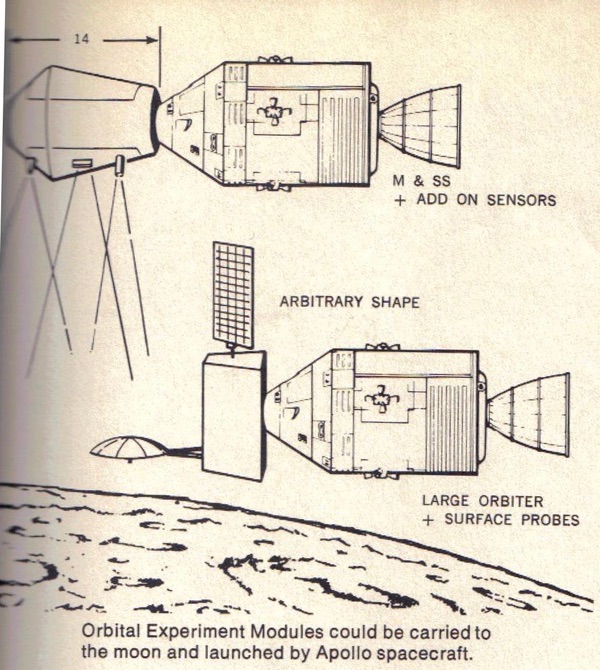 Notional illustration from a 1968 encyclopedia showing the LMSS |
Photographing a Crash Site
By this time those working on the program had suggested another use for the LMSS: “a quick-reaction photographic capability to survey accidents that might occur on the lunar surface.” But in late July, Seamans concluded that the LMSS “did not have the required flexibility” for this mission because it would require a separate Saturn V flight considerably later than an accident. Seamans therefore determined that the program should be terminated and the LMSS hardware stored until NASA could decide what to do with it.
The discussion also convinced Seamans that it might be useful to have a low-cost way of photographing equipment on the lunar surface in event of an accident, especially for the first landing mission. He wrote “ideally, the CSM should be able to obtain meaningful information about any LM accident before returning to earth. While the possibility of an incident in which photography would be the only data available for analysis is considered very remote, I feel it would be worthwhile to have a simple high-quality CSM photographic system available before the first lunar landing.” If a Lunar Module crashed, it would be the responsibility of the surviving astronaut, the Command Module Pilot, to photograph the accident site from orbit before heading home, all by himself.
In July 1967, Seamans sent a memo to NASA’s Associate Administrator for Manned Space Flight indicating that NASA could not justify continuing the LMSS. He also asked for an assessment of photographic reconnaissance systems that could perform the landing site analysis mission. These included handheld cameras in the Command Module, Service Module-mounted camera systems then in the planning stages, and Block I and Block II LMSS systems. Seamans asked for a rapid assessment of these capabilities and the requirement.
Seamans added that he would also like to discuss “the possible uses, for other missions than lunar mapping and survey, of the two sets of LMSS equipments about to be delivered, so that we can achieve maximum benefit from our investment to date.” This opened up a whole new can of worms for the National Reconnaissance Office. The Director of the NRO, Alexander Flax, was not happy with the idea of NASA continuing the LMSS if it was no longer needed to support Apollo.
There was an additional problem: Kodak was discontinuing the GAMBIT-1 camera system in favor of the much more powerful GAMBIT-3, also designated the KH-8. The first GAMBIT-3 had flown in July 1966. The last GAMBIT-1 launched in June 1967 and the NRO was no longer paying for it. With the GAMBIT-1 retired, any work on camera systems derived from GAMBIT-1, like that used for the LMSS, would have had to bill all the costs, including overhead, to the LMSS program, meaning NASA’s costs would rise substantially. On July 25, 1967, Seamans informed senior NASA officials that he planned on canceling LMSS. But he waited until after the successful launch of Lunar Orbiter V in August 1967 before informing the NRO of his decision.
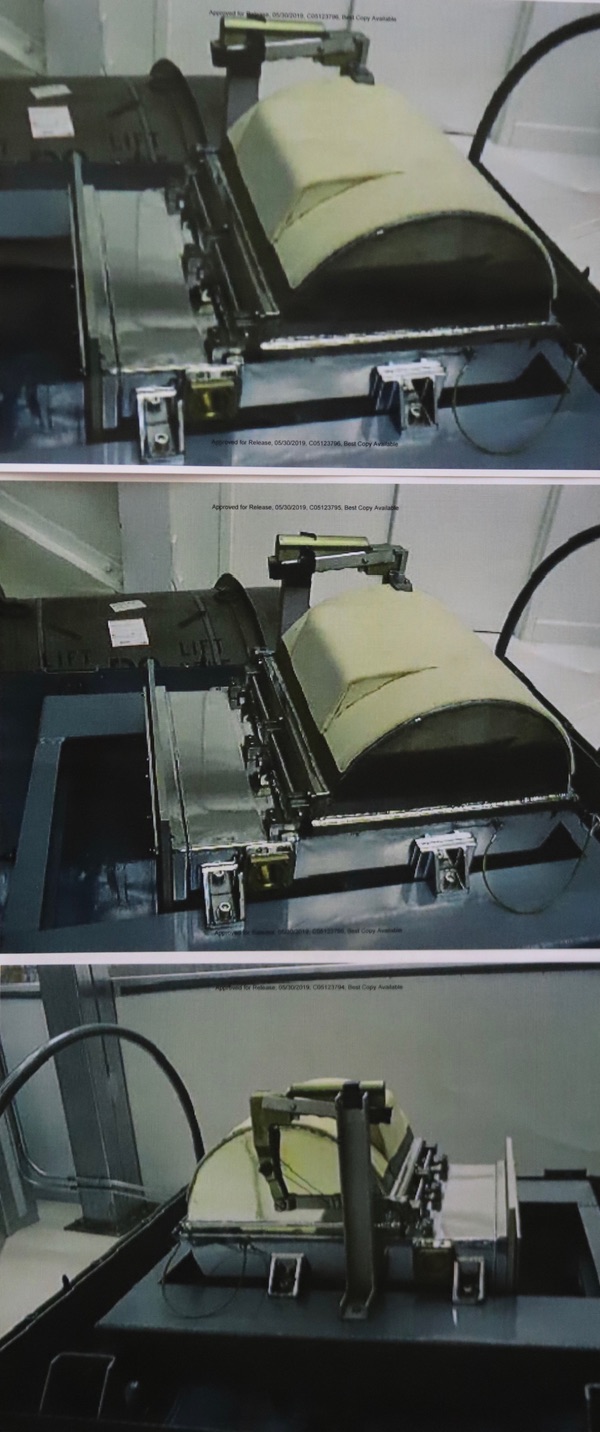 Newly declassified photos of the only remaining hardware from the UPWARD program. These film takeup canisters would have been recovered by an Apollo astronaut at the end of the photography mission. (credit: NRO) |
Preserving UPWARD
Seamans ordered that the classified hardware produced for the Lunar Mapping and Survey System be placed in storage awaiting further decision on what to do with it. This consisted of four units in various stages of development, including two that were nearly complete. Apparently somebody at JPL later again proposed that the camera system be carried on lunar landing missions, but the system was simply too big and heavy to be carried with any mission that included a Lunar Module.
| What the UPWARD/LMSS story tell us is that 50 years after the Moon landing, the story of Apollo is far from complete. |
What happened to the stored hardware remains unclear. The hardware was classified. At least initially it would have been stored by the contractor—either Lockheed or Kodak. But contractors do not store equipment for free, and at some point NASA probably either transferred the remaining LMSS hardware to the NRO, or ordered it destroyed. Even if it was transferred to the NRO it may have been later destroyed as surplus. However, two film take-up canisters, which would have been retrieved by the astronauts with the exposed film inside and returned to Earth, were apparently preserved and still exist. Although they are not currently on public display anywhere, they would be good additions to a museum able to properly place them in context, like the Kansas Cosmosphere. This article contains the first ever published photos of this hardware.
NASA also considered using the LMSS as part of a space station in Earth orbit. Some unclassified NASA documents included simple line drawings of the exterior of the Lunar Mapping and Survey System, although no description of it. The LMSS was depicted as a large cylinder that would be connected to the Apollo CSM docking port and then maneuvered into place on the space station. A couple of illustrations depict it inside a large truss structure that would hold it inside the Saturn Launch Adapter. Other illustrations show no truss structure. Although some kind of structure would have been required to carry the LMSS inside the Saturn, at the time engineers had not decided if it was possible to pull the large camera out of the truss, or if they would leave the truss attached. For Earth orbit operations the mass penalty would have been unimportant, but the truss would obscure the Command Module pilot’s vision and made it harder to attach to the space station. (A future Space Review article will discuss the Earth orbit phase of the UPWARD/LMSS history.)
The code name UPWARD was classified, along with technical details of the equipment, but the existence of the LMSS program was not classified. NASA did nothing to publicize the project during Apollo. It is not mentioned in official histories or the hundreds of popular books about the Apollo program. The only known contemporary mention of it is very obscure: in the Above and Beyond Encyclopedia, published in 1968. The encyclopedia entry noted the LMSS would be carried in the Saturn Launch Adapter in place of the Lunar Module and would consist of a “high resolution survey camera and a moderate-resolution mapping camera in combination with a stellar index camera.” The book stated that 75 pounds of film would be exposed and then retrieved by an astronaut and added that “four LM&SS devices are being developed.” The entry was accompanied by two illustrations, one showing the spacecraft in a lunar polar orbit, although this may not have been the actual planned orbit. Obviously, whoever wrote the entry obtained the information from NASA, because it was an accurate description of the program. But other space historians were apparently unaware of LMSS for decades after the program existed.
What the UPWARD/LMSS story tell us is that 50 years after the Moon landing, the story of Apollo is far from complete. There may still be more secrets of Apollo lurking in the darkness.
Note: we are temporarily moderating all comments subcommitted to deal with a surge in spam.
